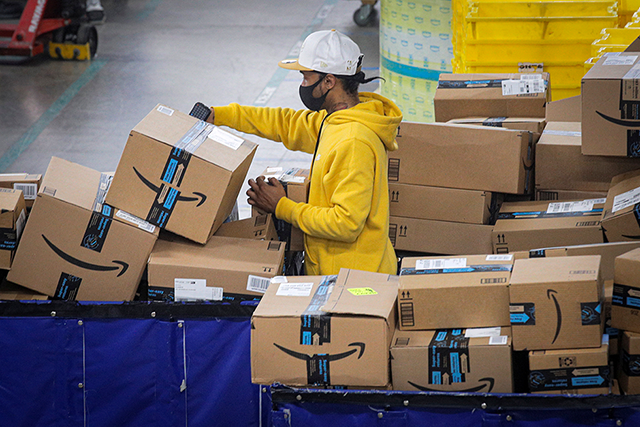Online retail sales are way up. So are local sales tax collections in Minnesota. – MinnPost
A report from the Center for Rural Policy and Development showed some counties’ local sales tax collections up 20 to 30 percent since 2015.
In Minnesota, 49 counties and 45 cities — from St. Paul to Bemidji and from Hennepin to Crow Wing — have adopted something called a “local option” sales tax.
The idea is, when people buy things in these particular cities or counties, a small percentage of the tax generated by the sales goes toward local government.
With the rise of e-commerce, Minnesotans all over the state are buying more things from online, out-of-state retailers than they were just a few years ago. Has that caused a big hit to local sales tax collections? Not quite, according to a new report from the Center for Rural Policy and Development (CRPD).
Article continues after advertisement
Nationwide, e-commerce sales have more than doubled as a share of all retail sales in less than a decade, increasing from about 5 percent of total retail sales in 2012 to more than 12 percent in 2021, according to Census figures.
All that e-commerce means that overall more goods are being bought from retailers located outside of consumers’ immediate communities.
According to Minnesota Department of Revenue statistics, the share of retail taxable sales coming from outside of Minnesota has risen by 171 percent between 2010 and 2019. But retail taxable sales in Minnesota have risen, too, by 32 percent.


All that increase in consumer spending on retail goods has been good for the local governments that have local option sales taxes, including both cities and counties.
Looking at the trendlines, “There’s nothing here that we should be worried about,” said Kelly Asche, an author of the report and a research associate at the CRPD during a webinar about the report. A chart of county local sales tax revenues showed increases between 20 percent and 30 percent since 2015. From a sales tax perspective at least, e-commerce hasn’t harmed local governments’ bottom lines.
Local governments’ ability to capture sales tax revenue from online sales has benefited from a 2018 U.S. Supreme Court decision, South Dakota v. Wayfair. As a result of that ruling, companies with more than 200 sales or more than $100,000 worth of sales in the prior 12 months in Minnesota must pay Minnesota state and local sales taxes. Previously, companies were only required to remit such taxes if they had a physical presence in the state.
Asche also credited technology that makes it easy for companies to pay taxes to the correct jurisdictions, as well as clear guidelines concerning sales tax remittance for companies established by the Minnesota Department of Revenue.
Crow Wing County Administrator Tim Houle said he was pleased with the report’s findings. The report found that revenues from the local option sales tax in Crow Wing County, a part of the state that includes the Brainerd Lakes area, have increased in recent years. The tax in Crow Wing County helps to pay for transportation infrastructure.
Article continues after advertisement
While e-commerce hasn’t tanked local sales tax collections, the rising number of online sales has had mixed effects on local businesses themselves.
The number of retailers has declined in all types of communities — by as much as 17 percent since 2004 in entirely urban areas in Minnesota, according to the report, and as much as 24 percent in areas with a town and rural mix.


That’s a continuation of a trend that’s been going on for more than a century, said Ryan Pesch, an author of the report and a University of Minnesota extension educator in West Central Minnesota.
“This trend we published in the report about less stores but more sales, it’s essentially been going on since 1900 or something. At some point we hit peak stores in Minnesota,” he said.
The rise in online sales has also forced changes in brick and mortar stores. First, it’s made prices more uniform across retailers, as brick and mortar stores have lowered prices to compete with online retailers because, particularly in the early days of e-commerce, shoppers could look at an item in a physical store but buy it online if it was cheaper there.
Second, it resulted in more experience-based shopping, whether that’s through events, workshops or demonstrations, as brick and mortar stores try to lure shoppers in with incentives to come to stores.
And third, it’s required physical stores to incorporate technology — a trend that accelerated during the pandemic with online shopping and curbside pickup — that makes it easier to shop locally.
Article continues after advertisement
In general, these changes have resulted in a decline in profits for brick and mortar stores, and in some cases, closure. But it’s also brought opportunities for Minnesota companies, as highlighted by panelists in a forum discussing the report.
Andrew Tjernlund, the co-owner of Tjernlund Products based in White Bear Lake, said his 83-year-old family business has become the larges supplier to the industrial electrical sector on Amazon. He estimates Amazon accounts for two-thirds of the company’s revenue.
“We’ve adjusted a family sheet metal manufacturing [company] to a company that represents or sells 400,000 products on Amazon,” he said.
Jena Thompson, the CEO of Daisy Blue Naturals, a beauty and wellness company based in Albert Lea sells through its brick and mortar stores and online through the company’s website. She described how, in a world where it’s easy to find millions of products on Amazon, her company has benefitted from not being Amazon. It also helps that people want to support local business, she said.


“Amazon has actually helped us by increasing our sales because people are looking for that unique item and you’re not going to find it on Amazon,” she said. “They’re looking for that unique experience — you’re not going to get that from Amazon.”
In other ways it has forced small companies like Daisy Blue Naturals to adapt to things like customers’ expectations of faster shipping times, Thompson said.
Another fear of local administrators and economic development officials has been that rise in online sales and decline in brick and mortar stores could negatively affect cities’ property tax bases.
The CRPD report found that while the number of retail firms has declined, commercial property makes up a small chunk of local tax revenue. Meanwhile, other property types — including residential, forest and agriculture — have increased significantly value, raising property tax collections.
“Other types of properties are making up for declines in retail and it’s just not having a significant impact so far on our property taxes for our rural areas,” Asche said.
MinnPost’s in-depth, independent news is free for all to access — no paywall or subscriptions. Will you help us keep it this way by supporting our nonprofit newsroom with a tax-deductible donation today?
Greta Kaul is MinnPost’s data reporter. She can be reached at gkaul@minnpost.com.
You can also learn about all our free newsletter options.
This list spans the last seven days.
is a 501(c)(3) nonprofit newsroom
Member donations are crucial to the work of our nonprofit newsroom. Our reporters are only able to do their work thanks to support at all levels.
Donations made by check can be made out to MinnPost and mailed to us at PO Box 18438, Minneapolis, MN 55418.
MinnPost | P.O. Box 18438 | Minneapolis, MN 55418 | 612.455.6950
* Please read before republishing *
We’re happy to make this story available to republish for free under an Attribution-NonCommercial-NoDerivatives Creative Commons license as long as you follow our republishing guidelines. See our full republication guidelines for more information.
To republish, copy the HTML at right, which includes our tracking pixel, all paragraph styles and hyperlinks, the author byline and credit to MinnPost.
If you have questions, email editors@minnpost.com.
— The Editors
By Greta Kaul | Staff Writer
Dec. 17, 2021
This <a target="_blank" href="https://www.minnpost.com/economy/2021/12/online-retail-sales-are-way-up-so-are-local-sales-tax-collections-in-minnesota/">article</a> first appeared on <a target="_blank" href="https://www.minnpost.com">MinnPost</a> and is republished here under a Creative Commons license.
Independent, in-depth journalism costs money to produce. MinnPost’s nonprofit reporting is available paywall-free thanks to the financial support of loyal readers like you. Will you make a tax-deductible donation today?




